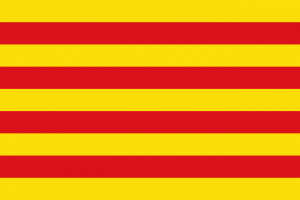Language/Catalan/Vocabulary/Common-Greetings
| ◀️ Basic Sentence Structure — Previous Lesson | Next Lesson — Introducing Yourself ▶️ |
Introduction
In this lesson, you will learn the most common greetings used in Catalan. These phrases are essential for basic conversations, allowing you to start connecting with new people, whether you're traveling in Catalonia, chatting with Catalan-speaking colleagues, or simply looking to expand your language skills. By the end of this lesson, you will be able to confidently greet others in Catalan, ask how they are, and more.
Once you've mastered this lesson, take a look at these related pages: Stores and Public Buildings & Farewell.
Basic Greetings
Let's start with the most basic of greetings: saying "hello" in Catalan. This phrase can be used in a variety of contexts, such as when you're meeting someone for the first time or simply passing someone on the street.
| Catalan | Pronunciation | English |
|---|---|---|
| Hola | [ˈɔ.lə] | Hello |
To respond to this greeting, you can simply say "Hola" back, or opt for another common response:
| Catalan | Pronunciation | English |
|---|---|---|
| Hola | [ˈɔ.lə] | Hello |
| Bona tarda | [ˈbo.nə ˈtaɾ.ðə] | Good afternoon/evening |
| Bona nit | [ˈbo.nə ˈnit] | Good night |
Note that "Bona tarda" is used more often in the afternoon, around 2 PM and beyond, whereas "Bona nit" is used before going to bed or when parting ways in the evening.
Another common greeting that you may encounter in Catalan-speaking regions is "Benvingut/da," which means "welcome." It's often used to greet visitors or new arrivals.
| Catalan | Pronunciation | English |
|---|---|---|
| Benvingut/da | [bəmˈviŋ.ɡut/də] | Welcome |
Asking How Someone Is
Now that you've learned some basic greetings, it's time to learn how to ask someone how they are in Catalan. There are a few different phrases that you can use, depending on the level of formality and how well you know the person.
The most common way to ask "how are you?" in Catalan is "Com estàs?" This phrase can be used in both formal and informal settings - just adjust your tone and choice of words as needed.
| Catalan | Pronunciation | English |
|---|---|---|
| Com estàs? | [kɔm əsˈtaz] | How are you? |
There are a few alternative phrases that you can use to ask the same question:
- "Com anem?" This is a more informal way of asking "how are you?" and is often used among friends or acquaintances.
| Catalan | Pronunciation | English |
|---|---|---|
| Com anem? | [kɔm əˈnem] | How are you? |
- "Com va tot?" This translates to "how's everything going?" and can be used in both formal and informal settings.
| Catalan | Pronunciation | English |
|---|---|---|
| Com va tot? | [kɔm βa tot] | How's everything going? |
To respond to these greetings, you can use a variety of phrases, from a simple "bé" (well) to more detailed responses.
| Catalan | Pronunciation | English |
|---|---|---|
| Bé | [ˈbe] | Well (response) |
| Estic bé | [əsˈtik ˈbe] | I'm well |
| Estic regular | [əsˈtik rəɣuˈlaɾ] | I'm doing okay |
| No em sento bé | [nu əm ˈsɛn.tu ˈbe] | I'm not feeling well |
Saying Goodbye
When it's time to say goodbye, there are several ways to do so in Catalan. The most common way to say "goodbye" is simply "adeu."
| Catalan | Pronunciation | English |
|---|---|---|
| Adeu | [əˈðew] | Goodbye |
In more formal settings or when speaking with people you don't know well, you may want to use the slightly more formal "Adéu."
Another common way to say goodbye in Catalan is "Fins aviat," which means "see you soon." This is often used when parting ways with friends or acquaintances that you plan on seeing again soon.
| Catalan | Pronunciation | English |
|---|---|---|
| Fins aviat | [fins aˈβjat] | See you soon |
For more casual goodbyes, you can use "fins ara" or "fins després," both of which roughly translate to "see you later."
| Catalan | Pronunciation | English |
|---|---|---|
| Fins ara | [fins əˈɾa] | See you later |
| Fins després | [fins dəsˈpɾes] | See you later |
Wrap Up
In this lesson, you learned how to greet others and say goodbye in Catalan, as well as how to ask someone how they are doing. These basic phrases are essential for starting conversations and connecting with new people, so be sure to practice them often. In our next lesson, you'll learn how to introduce yourself and others in Catalan, including how to share your name, age, and occupation.
Other Lessons
- Family Members
- How to use "to speak" in Catalan
- Sports and Games
- Food Vocabulary
- Numbers 1 100
- Time
- Idiomatic Expressions
- Common nouns and verbs for daily life
- Directions
- Numbers
Sources
- 14 Useful Catalan Words & Phrases for Expats | Barcelona Expat Life
- 20 Essential Catalan Phrases You'll Need in Barcelona
- Essential Catalan Phrases to visit like a local | Barcelona Eat Local ...
| ◀️ Basic Sentence Structure — Previous Lesson | Next Lesson — Introducing Yourself ▶️ |

